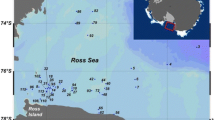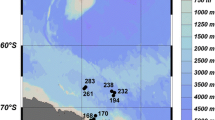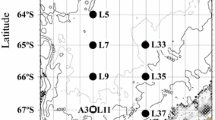Summary
Zooplankton species composition, abundance and vertical distribution were investigated in the upper 1000 m of Croker Passage, Antarctic Peninsula during the austral fall (March–April, 1983). 106 species were identified, many being mesopelagic and reported previously from the Southern Ocean. The most numerous species (>1000/100 m3) were the copepodsMetridia gerlachei, Microcalanus pygmaeus, Oncaea antarctica andOncaea curvata. Oncaea curvata alone constituted half the zooplakton population. Zooplankton biomass was dominated by three copepod species,Metridia gerlachei, Calanoides aculus andEuchaeta antarctica,which comprised 74% of the biomass. Size analysis revealed most of the zooplankton numbers were in the >1 mm fraction. The biomass distribution was polymodal with major maxima in the >1 mm and the 4–4.9 mm size classe. The >1 mm peak, exclusive of protozoans, was primarily copepod nauplii and copepodites ofOncaea, Metridia andMicrocalanus. The 4–4.9 mm peak was mostlyCalanoides acutus andMetridia gerlachei.
All of the principal species had broad vertical distributions both day and night. There was some suggestion of diel vertial migration byMetridia gerlachei andEuchaeta antarctica, with segments of their populations migrating into the upper 100 m and 200 m, respectively, at night. Most of the dominant and subdominant species were concentrated below 200 m,with only the subdominantOithona similis having its maximum in the epipelagic zone. The occurrence of zooplankton at winter depths appears to have been earlier in Croker Passage in 1983 than has been generally reported for waters south of the Polar Front.
Total standing stock of net-caught zooplankton (>15 mm) in the upper 1000 m was estimated at 3.1 gDW/m2, which is somewhat higher than values reported for the West Wind Drift and for open ocean areas of temperate to tropical latitudes.Euphausia superba (17–52 mm) dominated the pelagic biomass, exceeding zooplankton standing stock under a square meter of ocean by a factor of 15. This is in contrast to lower latitudes where zooplankton biomass is usually greater than macrozooplankton-micronekton.
Similar content being viewed by others
References
Andrews KJH (1966) The distribution and life history ofCalanoides acutus (Giesbrecht). Discovery Rep 34:117–162
Bellan-Santini D (1972) Invertebres marins des 12. et 15. expéditions antarctiques françaises en Terre Adelie. 10. Amphipodes gammariens. Tethys (Suppl) 4:157–238
Beyer F (1962) Absorption of water in crustaceans, and the standing crop of zooplankton. Rapp PV, Reun Cons Int Explor Mer 153:79–95
Davies TE, Barham EG (1969) The Tucker opening-closing micronekton net and its performance in a study of the deep scattering layer. Mar Biol 2:127–131
El-Sayed SZ (1971) Dynamics of trophic relations in the Southern Ocean: Research in the Antarctic. Am Assoc Adv Sci 73–91
Foxton P (1956) The standing crop of zooplankton in the Southern Ocean. Discovery Rep 28:193–235
Green KA (1977) Ecosystem modeling for the southern ocean. Antarct J US 12:34–55
Hamner W, Hamner PP, Strand SW, Gilmer RW (1983) Behavior of Antarctic krill,Euphausia superba: Chemoreception, feeding, schooling, and molting. Science 220:433–435
Hardy AC, Gunther ER (1935) The plankton of the South Georgia whaling grounds and adjacent waters 1926–1927. Discovery Rep 11:1–456
Hopkins TL (1971) Zooplankton standing crop in the Pacific sector of the Antarctic. In: Llano GW, Wallen IE (eds) Biology of the Antarctic seas. Am Geophys Union 17:347–362
Hopkins TL (1982) The vertical distribution of zooplankton in the eastern Gulf of Mexico.Deep-Sea Res 29:1069–1083
Hopkins TL, (in press) Food web of an Antarctic midwater ecosystem. Mar Biol
Hopkins TL, Baird RC (1975) Net feeding in mesopelagic fishes. Fishery Bull US 73:908–914
Hopkins TL, Lancraft TM (1984) The composition and standing stock of mesopelagic micronekton at 27°N86° W in the eastern Gulf of Mexico. Contrib Mar Sci 27:143–158
Hurley DE (1965) A common but hitherto undescribed species ofOrchomonella (Crustacea Amphipoda: Family Lysianassidae) from the Ross Sea. Trans R Soc NZ, Zool 6:107–113
Kaczmaruk BZ (1983) Occurrence and distribution of the Antarctic copepods along the ice shelves in the Weddell Sea in summer 1979/1980. Meeresforsch 30:25–41
Knox GA (1970) Antarctic marine ecosystems. In: Holdgate MW (ed) Antarctic ecology.Academic Press, London, pp 69–96
Lovegrove T (1962) The effect of various factors on dry weight values. Rapp PV Reun Cons Int Explor Mer 153:86–91
Mackintosh NA (1934) Distribution of the macroplankton in the Atlantic sector of the Antarctic. Discovery Rep 9:65–160
Motoda S (1959) Devices of simple plankton apparatus. Mem Fac Fish Hokkaido Univ 7:73–94
Nemoto T (1968) Feeding of baleen whales and krill, and the value of krill as a marine resource in the Antarctic. In: Proc Symp Antarct Oceanogr. Scott Polar Res Inst, Cambridge, England, pp 240–253
Nemoto T, Harrison G (1981) High latitude ecosystems. In: Longhurst AR (ed) Analysis of marine ecosystems. Academic Press, London, pp 95–126
Omori M (1978) Some factors affecting dry weight, organic weight and concentrations of carbon and nitrogen in freshly prepared and in preserved zooplankton.Int Rev Gesamten Hydrobiol 63:261–269
Ostapenya AP, Shushkina EA (1973) Caloricity of net plankton and energy equivalents of the body mass of some tropical activity of pelagic communities in the tropical oceans (Engl transl), Nauka, pp 190–197
Owre HB, Foyo M (1967) Copepods of the Florida current. Fauna Caribaea, vol 1 Crustacea. Part 1. Copepods. Inst Mar Sci, Univ Miami, pp 1–137
Raymont JEG (1963) Plankton and productivity in the oceans. Pergamon Press, London, 660 pp
Sewell RBS (1948) The free-swimming planktonic Copepods. Geographical distribution. Sci Rep Murray Exped 8 (Zool) 3:317–592
Tranter DJ (1982) Interlinking of physical and biological processes in the Antarctic Ocean. Oceanogr Mar Biol, Annu Rev 20:11–35
Vervoort W (1951) Plankton copepods from the Atlantic sector of the Antarctic. Verh K Akad Wet Amsterdam (Tweede Sectie) D1 47:1–156
Vervoort W (1957) Copepods from the Antarctic and sub-antarctic plankton samples. Rep BANZ Antarct Exped(B) 3:1–160
Vinogradov ME (1970) Vertical distribution of the oceanic zooplankton IPST translation. US Dept Interior Doc No TT 69-59015, 339 pp
Voronina NM (1973) Vertical structure of a pelagic community in the Antarctic Oceanology (Engl transl). 12:415–420
Author information
Authors and Affiliations
Rights and permissions
About this article
Cite this article
Hopkins, T.L. The Zooplankton community of Croker Passage, Antarctic Peninsula. Polar Biol 4, 161–170 (1985). https://doi.org/10.1007/BF00263879
Received:
Accepted:
Issue Date:
DOI: https://doi.org/10.1007/BF00263879




